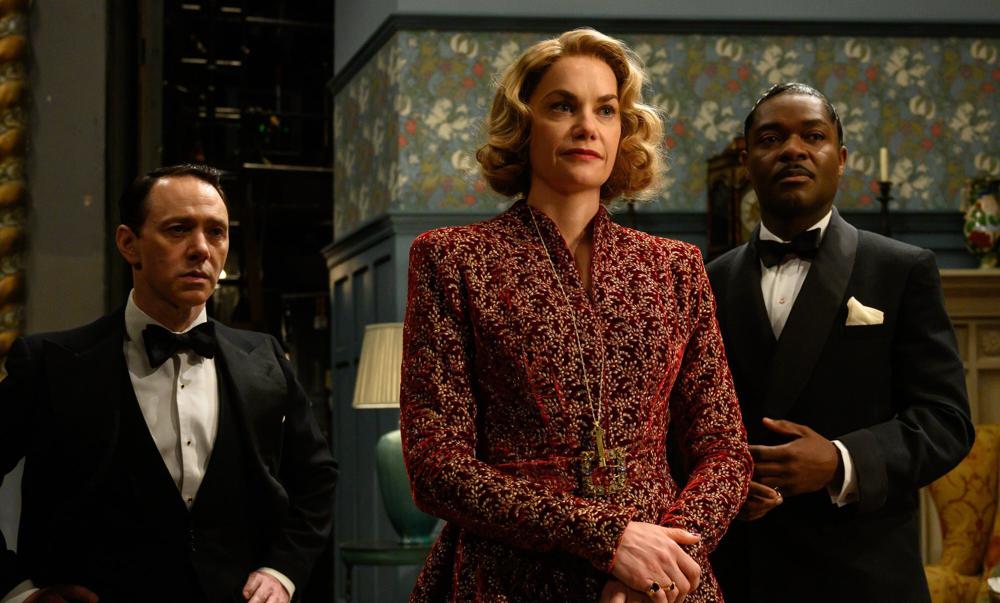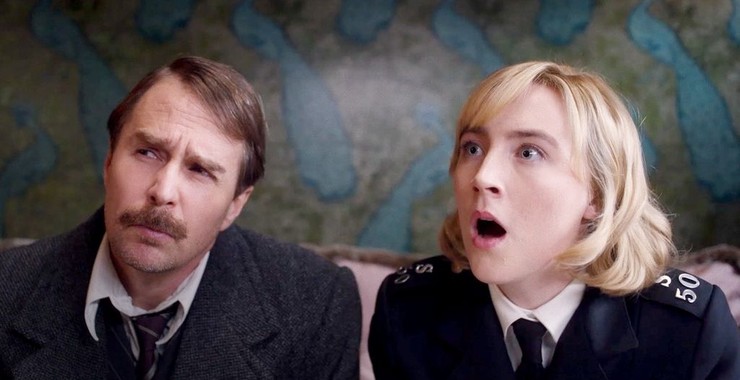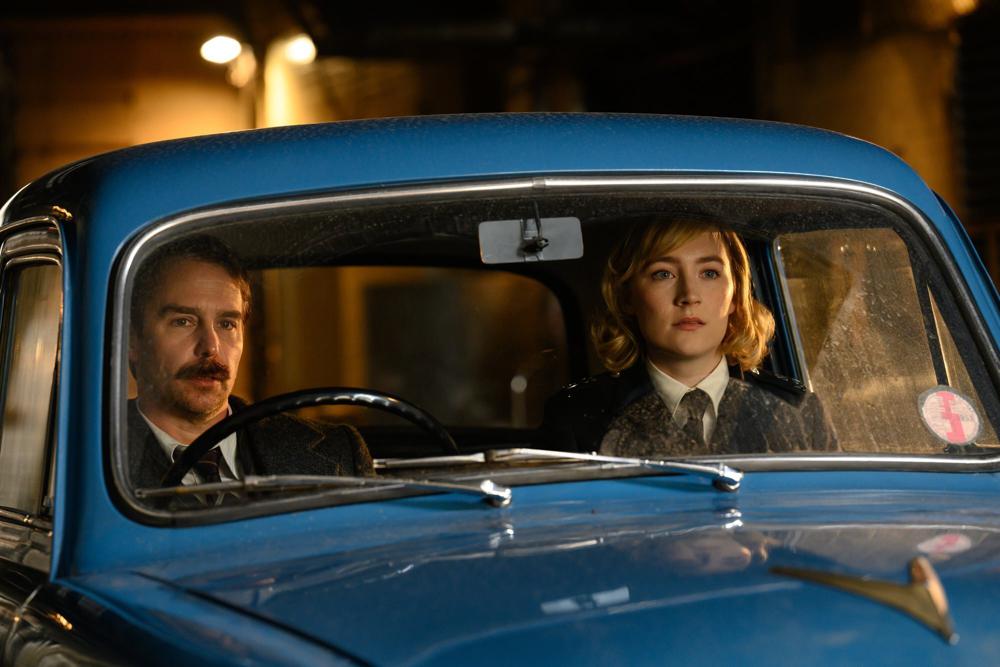KV: Agatha Christie, for all her faults, knew how to write a good mystery. Her novel And Then There Were None is the fourth best-selling fiction book of all time (for an example of her aforementioned faults, you can google the original title of that book, but trigger warning for extreme and disgusting racism). Given her status as one of the most successful mystery writers of all time, it may seem facile to say that she knows how to write a good mystery, but it bears remembering when watching See How They Run.

This movie, which Zoe and I recently watched in a suitably boomer-packed matinee, is, I suppose, intended to be a tribute to Christie and her play The Mousetrap, the longest-running stage production of all time. The strange thing about this movie is that it both requires a high level of knowledge of Agatha Christie’s stories and does away with everything that makes them good. The movie assumes that viewers come to it with a working understanding of the plot of The Mousetrap, so doesn’t really trouble itself with setting out what the play is about beyond a few crucial details. Far from Christie’s beguilingly tense and often prim, parochial settings, the atmosphere created in this movie was somewhere between a police procedural and a pantomime. I think maybe British people still actually like pantomime so I’m willing to admit that maybe some of this went over my head because I don’t understand the allure of yelling “He’s behind you!” at an actor or watching a puppet literally called “Punch” punch his puppet wife, but I digress. Zoe, do you want to give us a brief summary of the plot of See How They Run?
ZA: Yep, let’s do this. Okay, so the movie opens with the title card “West End, 1953” and an Adrien Brody voiceover setting the scene of the 100th performance of The Mousetrap and the tone of the film as smugly self-aware. He introduces himself and the key players of the impending whodunnit, while the audience is treated to glimpses of them amidst the hustle and bustle of the theatre experience and the subsequent 100th performance party. I’m just going to run through the gang real quick: Leo Kopernick (Brody) the scumbag-type Hollywood director hired to make the screen adaptation; Petula Spencer (Ruth Wilson), the play’s producer, whom Leo describes as “milkmaid in chief” (still not sure of what that means?); John Woolf (Reece Shearsmith), the weak chinned film producer; Edana, his “paranoid wife” (Sian Clifford); and Mervyn (David Oyelowo), the gay-coded and successful screenplay writer, who is played by a Black actor, coz we all know how chill 1950’s England was about both POC and gay people. I can’t believe there are more “key player,” I promise I’m over halfway. There are the two lead actors in the play, Dickie Attenborough (Harris Dickinson) and Sheila Sim (Pearl Chanda), and Mervyn’s fiery European implied partner, Gio (Jacob Fortune-Lloyd) (who Merve later refers to as his nephew, how funny is being closeted).
The audiences see snippets of the 100th performance celebration, laying some groundwork of some tensions between the players, leading to a fight between Leo and Dickie where the former is thrown into a big fancy cake sent by Agatha Christie (Shirley Henderson, a.k.a. Moaning Myrtle). Leo goes backstage to clean himself where he meets his end at the hands of the figure-in-the-long-coat-and-felt-hat (the ‘who’ in this whodunnit) by being bonked on the head with a sewing machine.
We now meet our heroes, Constable Stalker (Saoirse Ronan), the inexperienced but earnest, widowed-by-the-war mother-of-two (that particular storyline is mentioned once and never again touched on) and Inspector Stoppard, played by Sam Rockwell in his mumbliest role yet, who fills the jaded, sloppy old dog foil to Ronan’s doe-eyed enthusiasm. The pair are the investigators on the scene and unsurprisingly are tasked with pairing up to investigate the mystery by the puffy Commissioner (Tim Key), who is relatively funny here, providing some decent “British people are stuffy and rigid” gags throughout the film.
The rest of the film follows Stalker and Stoppard’s investigation and secondarily, their dynamic and how they learn and change from their partnership. (Aw). The investigation is largely through conversations with the various key players, invariably triggering a split-screen flashback of what they were talking about, followed by Constable Stalker jumping to a conclusion and Stoppard mumbling something dismissive.
There’s also an inexplicable dream sequence after Stoppard gets bonked on the head (the second and not the last head bonk of the film) with pantless Sam Rockwell getting a bev from Adrien Brody in an icy landscape. Not super important but I thought you should be aware.
Honestly, the film did quite a good job at being twisty (or maybe convoluted?), so going into the finer details of the investigation and the various rabbit holes will not be fun for me or you, so I’ll leave it at that. Hit me with your thoughts, Valenta.
KV: Look, I am incredibly easy to please when it comes to murder mysteries – my appetite for this sort of stuff is both indiscriminate and voracious. It’s therefore honestly quite a feat to disappoint me. One of my favourite things about Agatha Christie stories in particular is that they don’t generally follow the zigzagging path of a police procedural. Her most popular investigators are often unassuming, quaint, and idiosyncratic enough to inveigle themselves into the confidences of the key players, often without anyone even realising that they are methodically investigating. They are not, in other words, cops. Of course the writers of this movie tried to serve up a few quirks, but Rockwell’s occasional theatrical donkey kick sneezes and Ronan’s incessant note-taking weren’t enough to disguise the fact that he didn’t seem to be a very good detective, and she kind of had the vibe of a sentient bitmoji.
In Christie stories, it’s often the setting that enables the mystery to unfold. This fact is alluded to in one of many slightly nauseating, fourth-wall-jostling moments in See How They Run, with one of the characters noting that Christie stories often take place in a big country manor. Through some contrivance or other, the major players are usually thrown together, allowing the investigator unique opportunities to observe and uncover secrets, murderous and otherwise. In See How They Run, employing this device only at the end once the investigation was already essentially done, and having the killer reveal themselves before the investigators had arrived to tell anyone, felt like a real letdown.
ZA: Thinking about this movie has honestly given me a headache. I am just baffled trying to square away the film’s attempt to simultaneously subvert and align with the whodunnit genre, all with a knowing wink to the audience. Leo is dripping with contempt for The Mousetrap and the predictability of the form. As the director of the adaptation, he aims to Hollywoodize, add flashbacks and title cards, end with a violent conflict etc. The other characters are dismayed at these suggestions, countering that it is “lazy” and basically an affront to the Christie legacy. This point is even at the heart of the conflict between Mervyn and Leo. But the film we end up with is Leo’s vision of a Christie story? Is this film a critique of how the dialogue heavy/actionless (sorry KV) investigative narrative is impossible to be put to a modern audience and inherently has to be destroyed to do so? I have clearly spent far too long thinking about this movie so I am going to hand this back to Katie.
KV: Yeah I got a bit stuck wondering who this movie is for if not for people who like bog standard Christie adaptations. Unfortunately, I think the answer is people who want to feel nostalgia for a not-so-distant (but entirely fictional) past in which British sensibilities are something to feel proud of, but in which racism, homophobia and sexism don’t exist for the most part, and a young Irish policewoman is treated with dignity and respect by her English superiors. I don’t want to be too much of a killjoy, because some of the slapstick moments were received with much hooting and hollering by our fellow matinee attendees. There were some fun odd couple moments between Ronan and Rockwell, and the many misdirects did have me puzzled about who the killer was, so to that extent it achieved the main goal of a murder mystery. Ultimately, though, the film was too self-referential (and self-satisfied) for the mystery to develop in an engaging way, and the positives didn’t come close to making up for that in my view.
See How They Run is currently playing in cinemas.



